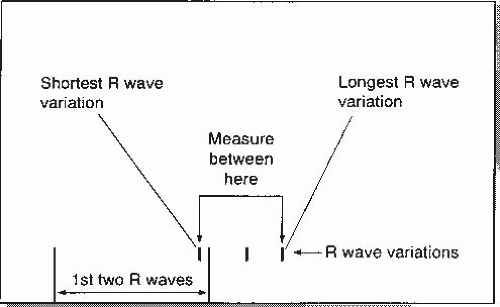Analyzing a Rhythm Strip
There are five basic steps to be followed in analyzing a rhythm strip. Each step should be followed in sequence. Eventually this will become a habit and will enable you to identify a strip quickly and accurately.
Step 1: Determine the regularity (rhythm) of the R waves
Starting at the left side of the rhythm strip, place an index card above the first two R waves (Figure 5-1). Using a sharp pencil, mark on the index card above the two R waves. Measure from R wave to R wave across the rhythm strip, marking on the index card any variation in R wave regularity. If the rhythm varies by 0.12 second (3 small squares) or more between the shortest and longest R wave variation marked on the index card, the rhythm is irregular. If the rhythm doesn’t vary or varies by less than 0.12 second, the rhythm is considered regular.
Calipers may also be used, instead of an index card, to determine regularity of the rhythm strip. R wave regularity is assessed in the same manner as with the index card, by placing the two caliper points on top of two consecutive R waves and proceeding left to right across the rhythm strip, noting any variation in the R-R regularity
The author prefers the index card method, because each R wave variation (however slight) can be marked and measured to determine if a 0.12-second or greater variance exists between the shorter and longer R-wave variations. With calipers, a variation in the R-wave regularity may be noted, but without marking and measuring between the shortest and longest R-wave variation, there is no way to determine how irregular the rhythm is. Examples of rhythm measurement are shown in Figures 5-2, 5-3, and 5-4.
Step 2: Calculate the heart rate
This measurement will always refer to the ventricular rate unless the atrial and ventricular rates differ, in which case both will be given. The ventricular rate is usually determined by looking at a 6-second rhythm strip. The top of the electrocardiogram paper is marked at 3-second intervals; two intervals equal 6 seconds (Figure 5-5). Several methods can be used to calculate heart rate. These methods differ according to the regularity or irregularity of the rhythm.
Regular rhythms
Two methods can be used to calculate heart rate in regular rhythms:
▪ Rapid rate calculation — Count the number of R waves in a 6-second strip and multiply by 10 (6 seconds × 10 = 60 seconds, or the heart rate per minute). This method provides an approximate heart rate in beats per minute, is fast and simple, and can be used with both regular and irregular rhythms.
▪ Precise rate calculation — Count the number of small squares between two consecutive R waves (Figure 5-6) and refer to the conversion table printed on the inside back cover of the book. A removable conversion table is also provided. Although this method is accurate, it can be used only for regular rhythms. If a conversion table isn’t available, divide the number of small squares between the two consecutive R waves into 1500 (the number of small squares in a 1-minute rhythm strip). The heart rates for regular rhythms in the answer keys were determined by the precise rate calculation method.
Irregular rhythms
Only rapid rate calculation is used to calculate heart rate in irregular rhythms. Count the number of R waves in a 6-second strip and multiple by 10 (Figure 5-7), or count the number of R waves in a 3-second strip and multiply by 20 (3 seconds × 20 = 60 seconds, or the heart rate per minute).
Other hints
When rhythm strips have a premature beat (Figure 5-8), the premature beat isn’t included in the calculation of the rate. In this example the first rhythm is regular and the heart rate is 68 beats per minute (22 small squares between R waves = 68).
Stay updated, free articles. Join our Telegram channel

Full access? Get Clinical Tree






